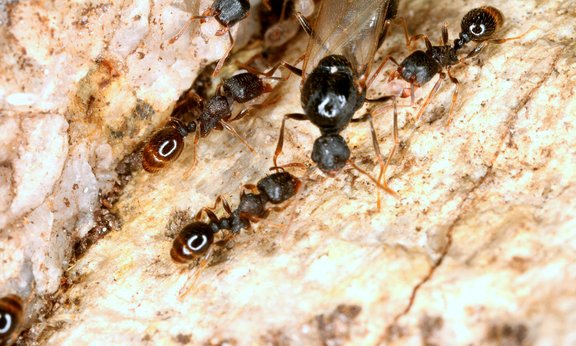The Innsbruck ecologists' study focuses on a species of ant that Florian Steiner and Birgit Schlick-Steiner themselves discovered and described for the first time in 2010: Tetramorium alpestre, an ant that occurs throughout the Alpine region and prefers a high-mountain habitat.“ Tetramorium alpestre is a crucial example of evolutionary adaptation to cold environments such as high-elevation habitats,” explains Birgit Schlick-Steiner from the Department of Ecology at the University of Innsbruck. Using a wide range of methods, the researchers have shown what molecular adaptations this ant species has undergone to adapt to this particular environment.
Comparative analysis
The mountain ant T. alpestre is very well adapted to life at above 2000 meters above sea level. For the study, the entire genome of T. alpestre was sequenced and analyzed together with all other available ant genomes. A comparison of the environmental conditions of all sequenced ant species showed the scientists that temperature during the warm season is critical for selection. While ants retreat to their nest deep below the ground during the cold season and keep dormant, the subalpine ant species is able to survive even in relatively cool summer temperatures. Through a comparative genomic analysis with four other Tetramorium species with different ecological needs, the researchers were able to identify some changes that have enabled the alpine species to adapt perfectly to this environment during evolution.
The genetic code
On the one hand, the team found indications in the genome of T. alpestre that positive selection favored certain genetic changes. On the other hand, the researchers also found that the selection pressure decreased for some genes. Many functions that are required by related species in their living environment no longer appear to be of great importance for the mountain ant species. As an example, Francesco Cicconardi, who is currently doing research at the University of Bristol, highlights so-called heat shock proteins with which organisms protect their cells from damage caused by environmental influences such as heat. It seems that the alpine ants are no longer particularly dependent on some of these proteins, which is why nature allows many genetic modifications without causing any damage to the animals. Other modifications become very important because they enable the ants to survive in very cold conditions. The researchers have therefore investigated the expression of certain proteins in cold shock experiments. They found that the subalpine species produces certain proteins in greater quantities than other species. “Both the genetic code and the expression of genes associated with environmental conditions are different in T. alpestre,” summarizes Francesco Cicconardi.
Dietary habits
Positive selection can also be seen in enzymes that regulate the sugar metabolism of the animals. The researchers were initially unable to explain this adaptation. They therefore returned to the ants' nests and found root lice that live together with the ants and apparently provide them with food. By genetically adapting their glucose metabolism, the subalpine ants are able to process this sugar very efficiently. Together with Daniele di Marino's research group at Ancona, the Innsbruck researchers succeeded in demonstrating this: Dynamic modeling of the respective molecule shows that the change in the ants' genome makes the enzyme much more flexible and thus enables it to establish a more stable bond with the target compound, the sugar, which in turn increases the efficiency of the process in the cells.
“Through our investigations we revealed how in the course of evolution this ant was able to survive even under inhospitable conditions,” says Florian Steiner. “The corresponding traces can be found in the genome.” The research was financed by the Austrian Science Fund FWF and carried out in cooperation with research groups in Austria, Italy, Great Britain, USA, and Hong Kong.
Links
- Genomic signature of shifts in selection in a sub-alpine ant and its physiological adaptations. Cicconardi Francesco, Krapf Patrick, D'Annessa Ilda, Gamisch Alexander, Wagner Herbert C, Nguyen Andrew D, Economo Evan P, Mikheyev Alexander S, Guénard Benoit, Grabherr Reingard, Philipp Andesner, Arthofer Wolfgang, di Marino Daniele, Steiner Florian M, Schlick-Steiner Birgit C. Molecular Biology and Evolution 2020
- Working Group Molecular Ecology
- Department of Ecology

